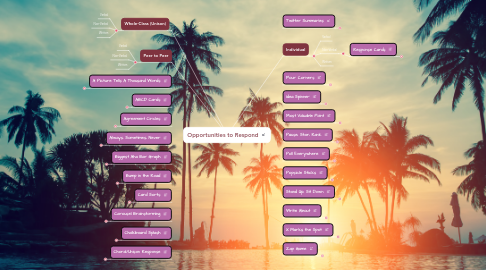
1. Whole-Class (Unison)
1.1. Verbal
1.2. Non-Verbal
1.3. Written
2. Peer to Peer
2.1. Verbal
2.2. Non-Verbal
2.3. Written
3. A Picture Tells A Thousand Words
3.1. Each student receives one set of four cards individually marked A,B, C, and D. Students hold up the answers as questions are asked.
4. ABCD Cards
4.1. Each student receives one set of four cards individually marked A,B, C, and D. Students hold up the answers as questions are asked.
5. Agreement Circles
5.1. Form a circle in the room. When a statement is read, students who agree with the statement step into the center of the circle. Those who disagree with the statement remain on the circumference of the circle. Those inside the circle then partner with students on the circumference to discuss and defend their thinking. Example: All squares are rectangles.
6. Always, Sometimes, Never
6.1. Presented with statements, students decide if each statement is always true, sometimes true, or never true. This can be done in various ways including having students hold up response cards, having students work in pairs to do a card sort or in using a piece of paper. Example: multiples of 5 always end in 5
7. Biggest Aha Bar Graph
7.1. Students record their biggest ahas on a Quick-Write half sheet, index card, post-it note or precut pieces of paper that are all the same size. Have one student share his/her response, then tape it to the wall. Ask students who selected the same or similar response to come up, share their responses, and tape them above the other students' response, forming the first column of the bar graph. Ask another student (who didn't already share) to come up, share his/her response, and tape it to the wall in a new column. Have students with same or similar response come up and complete the second column. Repeat this process until all students have posted their responses on the bar graph. At the end, you can tell which concepts made the biggest impact and which ones need revisited.
8. Bump in the Road
8.1. Students write down something from the lesson that they find confusing or difficult. The teacher then collects the responses and reviews with the whole group OR forms small groups and asks students to seek clarification from each other.
9. Card Sorts
9.1. Students work individually or in small groups to sort a set of cards according to a given characteristic or category.
10. Carousel Brainstorming
10.1. Split the class into groups. Each group get their own chart paper and colored marker. The idea is to have each group write down what they know about a topic. When time is up, groups rotate to each chart adding ideas and questions with their colored marker as they go. Once students return to their "home" station, groups can summarize what's listed and share summary/key points with whole group.
11. Chalkboard Splash
11.1. After given a sentence starter, prompt, or question, all students record their brief responses (or copy their brief Quick-Write or Quick-Draw) onto spots on a chalkboard/whiteboard or chart paper for all students to see. After all students have recorded their responses, students are asked to analyze peer responses, looking for similarities, differences, and surprises and record on a form (optional). Students could then get in small groups to share what they noticed in terms of similarities, differences, and surprises.
12. Choral/Unison Response
12.1. This technique involves all students responding in unison to a teacher, when prompted. Allow thinking time before prompting. Some types include: repeat, report (an answer), reinforce (having everyone repeat an important answer a student has given), review, and solve.
13. Twitter Summaries
13.1. Students summarize what they learned using no more than 140 characters.
14. Individual
14.1. Verbal
14.2. Non-Verbal
14.2.1. Response Cards
14.2.1.1. There are many variations of response cards (also called hold-ups), but they are generally used with the whole class at the same time. You can pre-print and distribute response cards or use individual whiteboards for short responses. The teacher asks a question or presents a situation, and all students, when prompted by the teacher, will hold up a response card. They can also be used in combination with other OTRs, such as allowing pairs or groups to confer or discuss before each student decides on which response card to hold up. Possible variations for response cards: green/yellow/red or green/red (for level of understanding, finished/not finished, etc.), ABCD (for multiple choice questions), selected response cards (many options, such as L, E, J for the three branches of government, etc.), True/Not True/True with Modifications/Unable to Determine based on information learned, etc.
